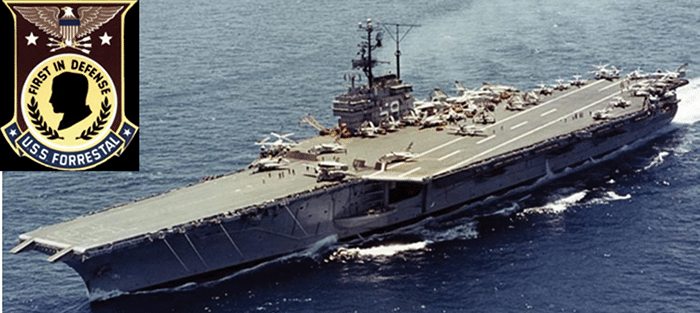The USS Forrestal (CVA-59, later CV-59, and AVT-59) was the U.S. Navy’s first supercarrier. Built in 1955, she operated in the Atlantic, the Mediterranean, and the Pacific through the 1990s. The ship suffered one of the Navy’s most devastating fires in 1967 but returned to service a year later. Like many other U.S. Navy ships built before the 1980s, the Forrestal was built using significant amounts of asbestos. U.S. Navy veterans who served on the Forrestal are at risk of malignant mesothelioma, asbestosis, and other asbestos-related diseases.

About the USS Forrestal
The USS Forrestal (CV-59) was a post-World War II Navy vessel ordered in 1951 and launched in 1954. She boasted several notable firsts, including being the first conventionally powered supercarrier built for the United States Navy, the largest carrier built at the time, and the first designed to carry jet aircraft. The ship made history in November 1963, when a test of its ability to accommodate full-stop landings and takeoffs of a C-130 Hercules set a record for the largest and heaviest airplane landing on a Navy aircraft carrier.
The Forrestal was the first of the four Forrestal-class ships to be built, the other three being the USS Saratoga, the USS Ranger, and the USS Independence. Originally designated CVA-59, she was named for James Vincent Forrestal, a noted figure in Navy history who rose to the ranks of Secretary of the Navy and who later was named the nation’s first Secretary of Defense.[1] The ship was frequently referred to as the FID because she was named for the “First In Defense.”
Built during a time when the nation’s defense focused on matching and dominating the expanding Soviet Union, the Forrestal and its sister ships reflected significant improvements in aircraft storage, maintenance, and flow, which continue to influence ship design today. It enhanced maritime security and protected sea lanes, established U.S. military presence across multiple combat theaters, and assisted in multiple humanitarian aid and disaster relief efforts during its four decades in service. Still, the Forrestal may be best known for a tragic incident in 1967 that claimed the lives of 134 sailors and subsequently improved future U.S. Navy damage control readiness.[1]
On July 29, 1967, the USS Forrestal was operating off the coast of Vietnam. There were 27 fully armed planes on her flight deck as she prepared to launch the second strike of the day against North Vietnamese targets. Several planes had already started their engines when a rocket accidentally fired from an F-4 Phantom jet fighter, striking an A-4 Skyhawk on the other side of the flight deck. Though the rocket passed through the Skyhawk without exploding and landed in the ocean, jet fuel that poured from the Skyhawk’s fuel tank was ignited, and the flames were fed by heavy winds.[2]
Several more planes caught fire, and the heat exploded bombs on the flight deck, severely damaging the carrier and killing men stationed there. More fuel tanks of other planes ruptured and exploded, creating several holes in the flight deck that allowed burning jet fuel into the quarters below. It took more than 24 hours for the entire crew, with support from several other Navy ships, to extinguish the fire. The damage was historic: 134 sailors were killed, 161 injured, and 20 aircraft destroyed. The ship was forced to suspend combat operations and underwent temporary repairs in the Philippines before returning to the U.S. for permanent repairs. The cost was $72 million and took two years.[2] Navy historians point to the lessons learned from the fire on the Forrestal as instrumental in multiple design and safety improvements that have significantly enhanced Naval readiness.[2]
Construction and Later Upgrades
The USS Forrestal was ordered by the U.S. Navy in July 1951, laid down in July 1952, and launched in December 1954. She was built at Newport News Shipbuilding in Newport News, Virginia, a shipyard that later became notorious for its use of asbestos. As the U.S. Navy’s first “supercarrier,” the Forrestal’s massive dimensions were unprecedented – stretching 1,067 feet with a 129-foot beam and displacing over 80,000 tons when fully loaded. It had a top speed of 33 knots, propelled by four Westinghouse geared steam turbines and eight Babcock & Wilcox boilers, and carried a complement of 552 officers and 4,988 enlisted men.[1]
Its enormous size accommodated the largest naval air wing of its era, establishing new standards for carrier aviation capabilities. The Forrestal’s flight deck design was revolutionary and transformed aircraft operations at sea. Her cutting-edge features included air search and long-range radar that were critical to detecting and tracking threats, as well as communications and navigation systems that made the ship an effective command center.[1]
The Forrestal was equipped with high-speed deck elevators linking the hangar and flight decks, steam catapults that hurled aircraft into flight, and arresting gear that enabled safe landings. Its armaments included Mark 25, 29, and 37 Sea Sparrow missile systems that defended against aircraft and missile threats and MK 15 Phalanx Close In Weapon Systems armed with 20mm Gatling guns. Most importantly, the ship could carry up to 90 aircraft, including fighters, attack planes, reconnaissance aircraft, electronic warfare planes, and anti-submarine aircraft, allowing it to carry out a wide range of missions.[1]
Upgrades and Renovations
Throughout its time of service, the USS Forrestal (CV-59) underwent numerous evolutions. Major upgrades enhanced the flight deck’s effectiveness, with advanced steam catapults and arresting gear systems allowing it to accommodate increasingly sophisticated aircraft. She was retrofitted with modernized radar and communication capabilities that enhanced the ship’s ability to detect threats, coordinate operations, and manage complex battle scenarios. In the 1970s, she was included in the Service Life Extension Program (SLEP), an overhaul that added cutting-edge weapons systems, including the Phalanx Close-In Weapon System (CIWS) for enhanced missile defense. These modifications extended the carrier’s usefulness.[1]
USS Forrestal Service and Deployment History
During its four decades of service, the USS Forrestal (CV-59) was sent on numerous deployments. Originally built to establish America’s maritime presence during the Cold War, the ship became a fixture in Mediterranean waters, where she served as an integral part of the U.S. Sixth Fleet’s operations. The Forrestal’s frequent patrols in the Mediterranean both deterred Soviet expansion, reassured European allies, and maintained regional stability.[1]
During the Vietnam War, the USS Forrestal carried out critical combat operations off the coast of Southeast Asia. Her air wings launched thousands of strikes against enemy targets while providing vital close air support to Allied ground forces. Though the ship’s time in Vietnam was marked by the tragedy of the 1967 fire, the loss of an aircraft that fell off of its flight deck, and another fire set by a crewmember that caused millions of dollars in damage to computer equipment, it was also noted for its commendable role and was awarded two Meritorious Unit Commendations as well as multiple campaign and service medals reflecting her contributions to the war effort.[1]
After the Vietnam War ended, the USS Forrestal was reclassified as a Multi-purpose Aircraft Carrier (CV-59). She was selected to be the host ship for the International Naval Review of the U.S. Bicentennial celebration and participated in multiple Nato exercises. Unfortunately, during these years, her deck was also the scene of multiple aircraft incidents resulting in death and damage. She continued to be involved in U.S. Navy operations and exercises, including serving during the Syria/Israel missile crisis and operating in the Arctic Circle as part of NATO Ocean Venture ’81. In 1983, she underwent a complete emptying of her equipment for rework or replacement designed to extend her useful life once again. In the late 1980s, she departed for a deployment in the North Arabian Sea, and received a visit from then-President George H.W. Bush during his Malta Summit before transitioning to a new role as a training carrier. She was redesignated AVT-59 in 1991 and decommissioned in 1993.[1]
Was the USS Forrestal Built Using Asbestos?
Before its severe health risks were fully understood, asbestos use was widespread in U.S. Navy vessels, including aircraft carriers like the USS Forrestal. The material was ordered for use by the military due to its exceptional fire-resistant and insulating properties. Because fire prevention was so critical at sea, especially on carriers that held enormous quantities of aviation fuel, asbestos was extensively integrated into the ship’s construction.
The carcinogenic material’s heat-resistant qualities made it particularly valuable for insulating high-temperature equipment, including the turbines and boilers that powered the enormous ship. Steam and hot water pipes throughout the vessel were wrapped in asbestos-based insulation, and many surfaces received asbestos-containing spray coatings for both fireproofing and thermal control.
Asbestos could be found in virtually every area of the ship, from critical safety equipment like firefighting gear to protective clothing to basic infrastructure components. It contaminated pumps, gaskets, valves, flooring, ceiling materials, adhesives, deck matting, and ropes.
The military used asbestos because it was inexpensive, had multiple applications, and because it was believed that it would save both its human and military assets. The material’s versatility and perceived safety advantages led to its incorporation into hundreds of different components throughout the ship. It wasn’t until the 1980s that it became known that it was hazardous to the health of everyone on board, as well as anybody involved in building, repairing, or updating the ship.
Who Was at Risk for Asbestos Exposure on the USS Forrestal?
The Department of Defense specifically required that asbestos be used in hundreds of military applications between the 1930s and 1980s. Though the intention was to protect both men and other investments through its fire-resistant properties and strength, it ended up causing significant harm and death. U.S. military veterans represent roughly one-third of all victims of malignant mesothelioma and a sizeable portion of those diagnosed with other asbestos-related diseases.
In terms of personnel aboard the Forrestal, they faced multiple risks of exposure to airborne asbestos fibers. Everyday shipboard activities frequently compromised the structural integrity of the asbestos fibers that made up so much of the ship’s construction and parts. Construction work, maintenance operations, repairs, and even normal vibrations from daily operations could damage asbestos-containing materials, releasing hazardous fibers into the air. Engine room and boiler room personnel faced particularly high exposure risks, as they worked in confined, poorly ventilated spaces surrounded by asbestos-contaminated equipment and its insulation. Maintenance crews were also vulnerable, as their work often required disturbing asbestos-containing materials: cutting into pipe insulation was just one way that dangerous fibers were released into their breathing space.
Veterans from the USS Forrestal Diagnosed with Asbestos Illnesses
There are many examples of Navy veterans who served on the USS Forrestal who later developed asbestos-related illnesses. These include:
- Navy veteran John P. Reeves was diagnosed with asbestos-related lung cancer after serving aboard the USS Forrestal for three years.
- Donald R. French, a Navy veteran who filed a personal injury lawsuit against General Electric Company and Westinghouse (CBS Corporation) after having been exposed to asbestos in their products while serving aboard the USS Forrestal beginning in 1965. Mr. French had been a machinist’s mate, and his primary duty was in the Forrestal’s Number 2 main engine room, where the defendants’ asbestos-containing turbine was located.[3]
- Navy veteran Arthur Dumas filed a mesothelioma lawsuit against multiple companies whose asbestos-containing equipment he was exposed to while serving. Included in his Navy tenure were the years from 1958 to 1960, when he was assigned to the Forrestal as a damage controlman third class. While onboard the Forrestal, he worked on pumps and valves associated with hotel services (hot water, cold water, plumbing, and sewage). He recalled materials that he used while repacking the valves and removing insulation from pumps. He was reassigned to the Forrestal in 1971.[4]
Compensation for USS Forrestal Veterans Diagnosed with Mesothelioma
Navy veterans who served aboard the USS Forrestal did so knowing that they faced danger while protecting our nation but had no idea that their health and lives would be affected decades later by having been exposed to asbestos. Though asbestos-related diseases are incurable, there are multiple ways that these service members can receive support and compensation.
The Veterans Administration (VA) provides both healthcare and disability compensation for veterans affected by service-related asbestos exposure, including receiving care at specialized VA medical centers and specialty cancer centers. While they aren’t able to take legal action against the military or government directly, they can pursue personal injury claims against the companies that manufactured and supplied asbestos materials to the Navy.
Specialized mesothelioma attorneys are best equipped to assist veterans in identifying the specific asbestos manufacturers that supplied materials to the USS Forrestal and to explain the legal process. In addition to pursuing the companies that continue to operate today, the companies that were forced into bankruptcy by their asbestos liabilities were required to establish asbestos trust funds to compensate their victims, and you may be eligible to file a claim with them as well. The best place to start is by making an appointment with an asbestos attorney as soon as possible, as there are limits to the amount of time you have to file a lawsuit.
References
- Navy Emporium. (N.D.). USS Forrestal CV-59: A Noble Steed.
Retrieved from: https://www.navyemporium.com/blogs/navy-blog-articles/uss-forrestal-cv-59?srsltid=AfmBOoo9Iiw9FisADZubmETnzN2XT-RMlhGBm7giHBl7pDiTT_qVQL-E - The Sextant. (July 28, 2017.) How the 1967 Fire on USS Forrestal Improved Future U.S. Navy Damage Control Readiness.
Retrieved from: https://usnhistory.navylive.dodlive.mil/Recent/Article-View/Article/2686245/how-the-1967-fire-on-uss-forrestal-improved-future-us-navy-damage-control-readi/#:~:text=One%20of%20the%20most%20serious,off%20the%20coast%20of%20Vietnam. - Justia. (11/10/16). Donald R. French, et al v. A.W. Chesterton Com[pany, et al.
Retrieved from: https://www.govinfo.gov/content/pkg/USCOURTS-ohnd-1_16-cv-01777/pdf/USCOURTS-ohnd-1_16-cv-01777-0.pdf - Justia. (2014.). Arthur Dumas v. ABB Group, Inc. et al.
Retrieved from: https://law.justia.com/cases/federal/district-courts/delaware/dedce/1:2013cv00229/51055/309/

Terri Heimann Oppenheimer
WriterTerri Oppenheimer has been writing about mesothelioma and asbestos topics for over ten years. She has a degree in English from the College of William and Mary. Terri’s experience as the head writer of our Mesothelioma.net news blog gives her a wealth of knowledge which she brings to all Mesothelioma.net articles she authors.

Dave Foster
Page EditorDave has been a mesothelioma Patient Advocate for over 10 years. He consistently attends all major national and international mesothelioma meetings. In doing so, he is able to stay on top of the latest treatments, clinical trials, and research results. He also personally meets with mesothelioma patients and their families and connects them with the best medical specialists and legal representatives available.


